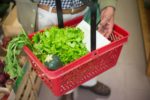Comparing the most recent statistics on Swiss consumer inflation to those in 1993 reveals a steep drop in the percentage of spending allocated to food.
When statisticians calculate consumer price rises they look at the prices of a standard basket of goods.
In 1993, food and non-alcoholic beverages made up 14.3% of the value of this standard basket. By 2018, the percentage had fallen to 10.4%, a 27% drop.
The chart below compares the percentages spent on food in 1993 and 2018.
The biggest falls were dairy and eggs (-46%) and meat and fish (-33%). The percentage spent on fruit and vegetables (-26%), bread and cereals (-17%) and non-alcoholic drinks were also down substantially.
Why?
Untangling trends in price and quantities bought is difficult. Switzerland’s Federal Statistical Office kept the basket fixed from 19931 until 2000 2. Then the basket was updated every year, muddying the financial waters.
Because the basket was fixed until 2000, we can see price trends until then. The price of milk fell by 16%. This means that up until 2000 dairy’s share of an average Swiss budget fell partly because of price. Over the same period meat (+11%), fruit and vegetables (+10%) and bread and cereals (+1%) all saw prices rise. This suggests some combination of price declines after 2000 and or changing buying preferences for these products – available data doesn’t allow these to be disentangled.
Unfortunately, any household budget gains made on food between 1993 and 2018 were more than swallowed up by a rising share of expenditure on health. This rose from 10.2% to 15.1% of the basket between 1993 and 2018, a rise of 45%.
Full story here Are you the author? Previous post See more for Next postTags: Editor's Choice,Environment,newslettersent,Personal finance,Switzerland inflation





































